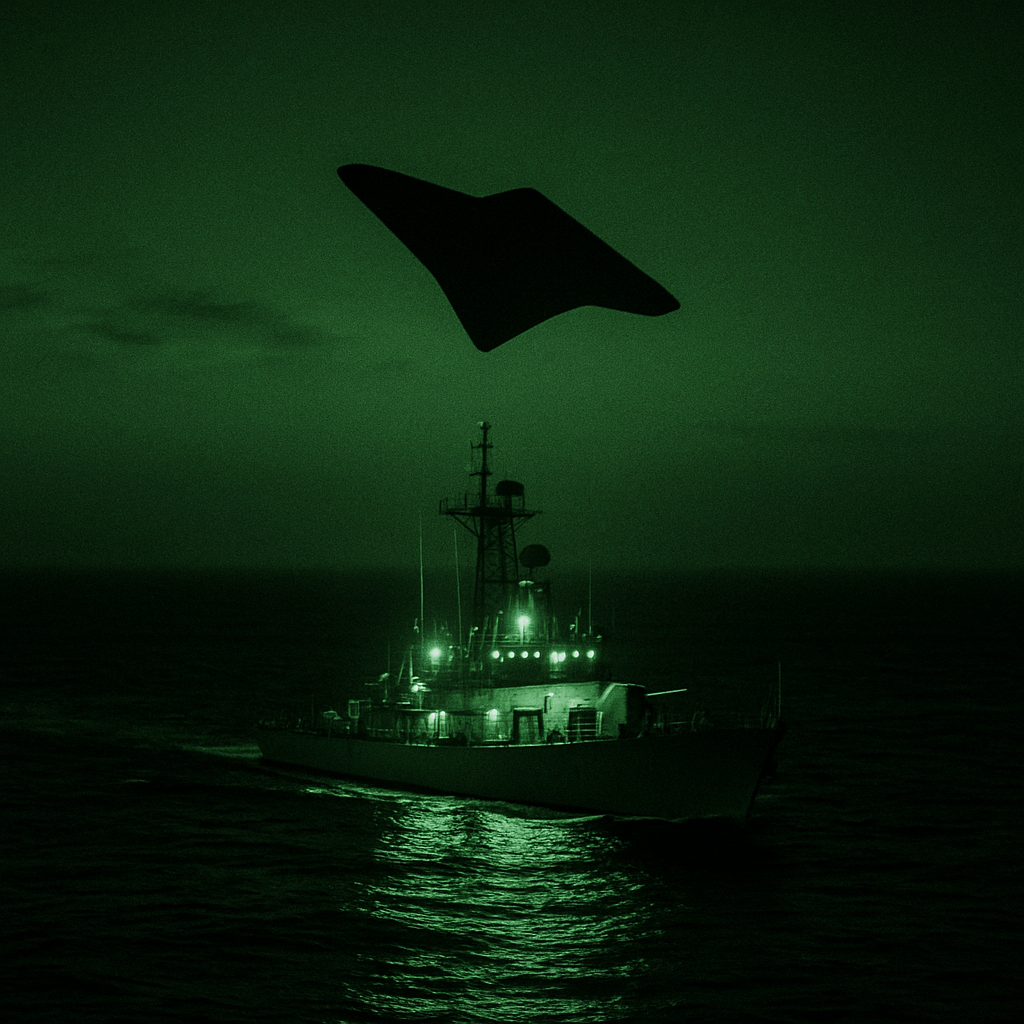UFO Pentagon Whistleblower Part 2: Immaculate Constellation (IMMCON) Program

In WEAPONIZED Episode #75, Part 2, titled “Immaculate Constellation – A UFO Whistleblower’s Journey,” the whistleblower Matthew Brown elaborates on critical elements of the classified UAP data archive, especially touching on systems like NRO Sentient, political dynamics involving Senators Rubio and Kirkpatrick, and even mythological symbolism like the Roman god Janus. Following up from Part 1, “UFO Whistleblower Goes Public: Pentagon Intelligence Insider Exposes Immaculate Constellation Program”, where whistleblower Matthew Brown first revealed the existence of the covert UAP surveillance archive known as Immaculate Constellation, this second installment expands the scope dramatically.
Matthew Brown describes how U.S. collection systems, including NRO assets, were capturing both “tasked” and “untasked” data on UAPs, implying that even when the system wasn’t explicitly looking for these anomalies, it was still picking them up—almost like the sensors were always watching. NRO Sentient is a highly advanced, AI-driven system that not only collects but likely interprets or flags anomalous activity across global surveillance feeds. This paints a picture of a surveillance infrastructure that is not only vast but possibly aware in some capacity—an idea hinted at in past whistleblower disclosures.
For the discussion involving Senator Marco Rubio and Dr. Sean Kirkpatrick, the whistleblower is crystal clear: Dr. Kirkpatrick, in his role as Director of the All-domain Anomaly Resolution Office (AARO), deliberately misrepresented the nature and findings of his investigations during classified briefings with Senators Marco Rubio, Elizabeth Warren, and Kirsten Gillibrand. The whistleblower, who read the full transcripts while serving at the Office of the Under Secretary of Defense for Intelligence and Security (USDI), experienced a chilling realization upon recognizing the depth of the deception. It wasn’t a simple difference of interpretation—it was, as the whistleblower put it, a deliberate distortion of the facts. The moment that crystallized this came when Senator Rubio, reacting to vague and evasive responses about the so-called legacy UAP program, exclaimed: “Well, what the hell is the executive branch doing? Have they been running this for 60 years without congressional oversight?” The whistleblower now saw themselves not just as an observer, but as someone carrying the weight of dangerous knowledge—evidence of systemic manipulation within the highest levels of the U.S. intelligence community.
Finally, in a moment of symbolic commentary, the whistleblower refers to the Roman god Janus—a two-faced deity often associated with transitions, beginnings, and duality. The name “Janus” here is metaphorically used to reflect the double-faced nature of the U.S. intelligence community’s approach to UAPs: one face shown to the public and to Congress, and another hidden deep within the classified compartments. It implies that disclosure has two sides—one genuine, one strategic—and that navigating it is like speaking to Janus himself, never sure which face is the truth. This poetic but sharp observation ties the mythological with the operational, highlighting the moral and psychological weight of being caught in a system that watches everything, says nothing, and expects obedience without transparency.
One of the most striking case examples Brown mentions—first alluded to in Part 1 and expanded here—is the incident involving a Russian naval vessel in the Atlantic Ocean. A green-tinged infrared image shows a black, angular UAP hovering above the ship at night. Unlike the previous sighting of a massive equilateral triangle in the Pacific, this craft was smaller and swept-back in shape, yet unmistakably solid and maneuvering with precision. What stunned analysts was the lack of any visible response from the Russian ship—no evasive action, no countermeasure attempts. Brown highlights this as one of the clearest indicators of non-human technology in controlled proximity to military assets. As noted in the report, U.S. assets were not even attempting to monitor UAP activity at the time—they were focused on the Russian vessel, and the UAP appeared incidentally. This underscores a key pattern in Immaculate Constellation surveillance: that the most revealing data often comes from systems not even actively seeking it.
The whistleblower recounts a second attempt to properly report the Immaculate Constellation material. This time, they met with another senior official in a SCIF and showed the document directly from the shared classified server. Initially, there was no visible reaction, but things changed when the individual paused on a slide connected to Lue Elizondo and began laughing exaggeratedly, dismissing it as a joke and refusing to document the incident. The whistleblower, surprised by the casual dismissal, left the meeting and immediately returned to check on the file—only to find it had been scrubbed from the system.
Further public confirmation of the Immaculate Constellation program’s existence helped dissolve any lingering doubts. After David Grusch’s testimony to Congress, search traffic for “Immaculate Constellation” spiked—before the public even knew about it—suggesting prior knowledge and legitimate exposure. The whistleblower found the entire experience disturbing, not just because of the contents of the document, but because of how government agencies and personnel responded—or failed to respond. Internal awareness of Grusch’s disclosures led to strange behavior within federal offices, with bureaucrats acting evasively and informally tracking the blowback. It was this environment of quiet panic and obfuscation that truly unsettled him.
He pointed to the fact that Congress felt compelled to pass new legislation like the Intelligence Authorization Act and the NDAA, which for the first time extended legal protections to whistleblowers from within intelligence and defense communities specifically regarding UAPs. The emotional tipping point, he explains, was reading a classified transcript of a briefing between Sean Kirkpatrick and Senators Rubio, Warren, and Gillibrand. Kirkpatrick, representing AARO, was tasked with investigating UAPs—but the whistleblower says he deliberately downplayed or outright lied about evidence. According to the transcript, Kirkpatrick waved off significant UAP reports as mere anomalies without sufficient data. But the transcript also documented an explosive reaction from Senator Rubio upon hearing vague answers about the so-called “legacy program.” Rubio, stunned, asked whether the executive branch had truly been running a covert UAP recovery and study effort for sixty years without any oversight from Congress. This moment, the whistleblower says, made his blood run cold—because it confirmed not only that the program existed, but that the cover-up extended deep into the fabric of the intelligence system itself.
This sense of betrayal led the whistleblower to reevaluate everything he had previously encountered. The document mentioning “Immaculate Constellation” wasn’t just some rogue file—it was part of a systematic collection and monitoring effort. The clincher came with his recognition of the NRO’s “Sentient” program, which is known (even in open sources) to manage large-scale autonomous surveillance and data analysis. This meant the intelligence community no longer needed buildings full of analysts to process UAP encounters—the software could sift, analyze, and sort anomalous behavior at scale. In other words, the machinery for an invisible, global surveillance dragnet was not only in place, it had already been quietly doing the job—leaving human oversight as little more than an afterthought. The true weight of that realization? The government wasn’t just hiding evidence of UAPs—it had built an entire invisible ecosystem to track and suppress them.
The whistleblower strongly suspects that when UAP data enters these classified channels, it is filtered and clarified in a way that sanitizes or omits the most disturbing or anomalous aspects. This practice isn’t new; during the Cold War, photo intelligence was manually edited to remove elements considered too sensitive for wider distribution. Today, similar sanitization is done algorithmically. He suggests that Immaculate Constellation, while not an AI scrubbing program itself, interacts with or sits atop a system that behaves that way, collecting data from satellites, reconnaissance platforms, and field sensors, then pulling those records into isolated compartments where access is strictly controlled based on compartmentalization, need-to-know, and SAP designations.
He describes how these black-box systems result in real-world consequences: service members on the front lines remain blind to threats in their operational environment, UAP reports vanish from internal systems, and recorded data never reappears. Sometimes the imagery itself is ingested into classified repositories and never returned to the operators who recorded it. Platforms like JWICS are bypassed entirely in favor of more obscure storage, and whistleblowers in combatant commands have repeatedly seen data disappear before analysis can even begin. According to the whistleblower, this deliberate stovepiping ensures plausible deniability, limits leaks, and suppresses unwanted disclosures, but at the cost of situational awareness and national security integrity.
In parallel to this, the whistleblower took steps to reach Congress after realizing that internal reporting mechanisms had been stonewalled. He initially doubted the significance of what he knew but later found validation when others—including David Grusch—began speaking out. He felt morally obligated to add his voice, especially after observing deception at the highest levels. His first attempt to report Immaculate Constellation internally was met with laughter and dismissal; follow-ups led to the file being deleted. Over time, he painstakingly constructed a full report detailing seven categories of evidence about the government’s knowledge of UAPs, while hiding drafts on encrypted drives and avoiding connected devices to guard against surveillance and foreign intelligence interception.
He eventually submitted this report to the State Department for prepublication review, met with Senate staff in classified settings, and ensured that copies were delivered to the relevant congressional committees. The prepub review returned with no redactions—an unexpected greenlight that, while unemotional and minimal in communication, allowed him to proceed. However, promised meetings with House representatives never materialized, and communication with congressional offices slowed to a crawl. He began to feel disillusioned—Congress had extended amnesty and legal protections, yet failed to provide follow-through. The whistleblower wasn’t just exposing the program; he was watching it actively sabotage any route to accountability.
Despite feeling dismissed, he stayed involved. He networked with other whistleblowers—some vocal, others private—joined discussions about creating a fund to support insiders afraid to come forward, and met with media contacts only when encouraged to help “start fires” to save the collapsing UAP Disclosure Act. But when that legislative effort failed, and when trusted figures in Congress failed to follow through, the illusion of a responsive democratic process shattered for him. He realized he was dealing not with a bureaucratic mishap, but with a system that actively insulated itself from external pressure, protected a sprawling surveillance and exploitation mechanism, and preserved the secrecy of a deeply controlled scientific paradigm.
In the final moments of the interview, the whistleblower reflects on what this knowledge means—not just for government policy, but for humanity. He suggests that we live within a carefully managed illusion, a synthetic version of reality shaped by classified science and compartmentalized data. UAPs, he believes, are not random visitations; they are here because of us. Sentient life, he concludes, may be the most valuable resource in the universe—and in that context, the concealment of UAP-related truths becomes not just a national security issue, but a profound moral and existential one.

